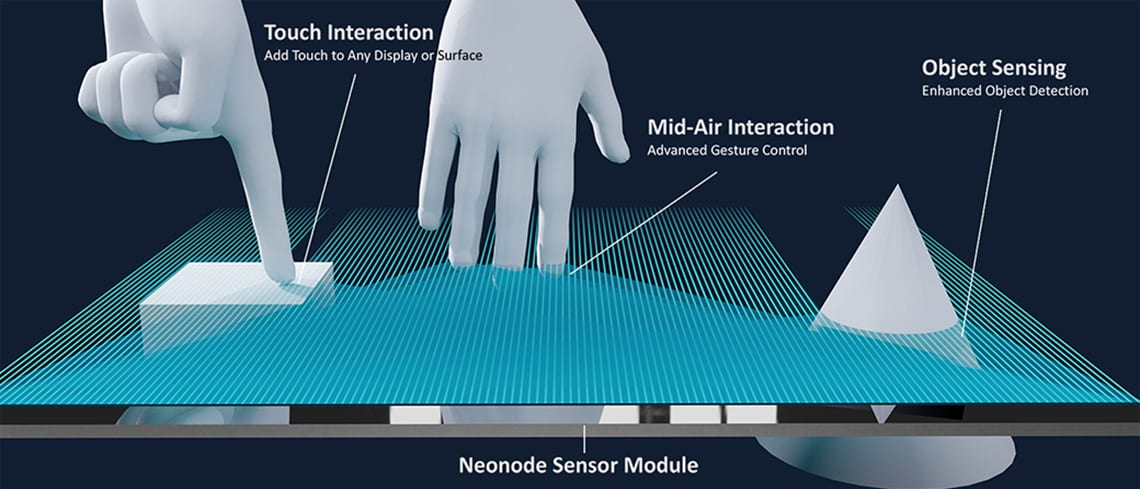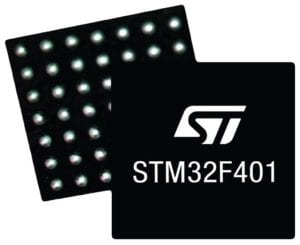The Sensor Module from Neonode, a Swedish company, uses infrared lasers to detect and track fingers or other objects on any surfaces or in the air. The system relies on a custom ASIC that drives the lasers and captures the signals from the receptors before it sends the raw data to an STM32F401C microcontroller (MCU), which serves as the module’s host. The Neonode sensor module can adapt to almost any size, from 43 mm to 346 mm in length, thanks to a modular approach that places small optical elements next to each other. The module connects to the host machine via USB HID or I2C to ensure it is easy to use for developers who can rapidly process the information coming from the modules to create new interactive interfaces.
This system is particularly ingenious because it allows the addition of a touch layer on any surface or display, regardless of its size, texture, color, or shape, and without any image distortion or color degradation. Engineers often don’t realize that all they need to do is add the Neonode sensor module at the edge of their design and connect it to their main board as the module comes calibrated and tested out of the box. Users can even use it outdoor in rough conditions, with gloves, or with multiple fingers, which makes it exceptionally versatile. The system has a relatively low power consumption since it only needs a USB 2.0 compliant 5 V supply, and although there are limitations and it isn’t trying to compete with small wearables, like smartwatches, one of the hardest things to understand about Neonode’s solution is the number of products it can drastically change.
The Originality of the Neonode Optical Reflective Technology

One of the reasons behind the success of the Neonode optical reflective technology is the exceptional care, and precision, the company puts behind each product. It uses custom optics, optimized firmware, and a mixed signal ASIC produced by ST, among other things, and it even has its own fully automated manufacturing plant in Sweden because the assembly of such a device is so complex Neonode needed to develop entirely new processes.
For example, the placements of the photodiodes and the alignments of the laser chips and lenses require such a high level of precision that they had to develop original manufacturing methods that satisfied the most stringent engineering tolerances for such a device. It also explains why the Neonode sensor modules have little competition, and why Neonode’s technology is quite unique in the industry.
The Partnership With ST
The fact that the company chose one of our STM32 MCU is thus highly symbolic. Neonode is clearly not afraid to face challenges head-on and create the technologies it needs to succeed. To trust us with their main microcontroller is thus a testimony to the quality and performance they saw in our products. As Bengt Edlund, Vice President of Global Sales at Neonode explained:
“We studied many different MCUs from various manufacturers and were looking for the most code-effective and well-supported architecture. We were also very attentive to the software tools each potential partner had, their support system, and pricing structure. An Arm core was an obvious choice, but as we looked for the best company supporting this instruction set, we also loved the fact that ST had such a broad catalog of products because it meant that we were bound to find the model that worked best for us today as well as a good product roadmap match with our technology needs going forward.”Neonode also told us that they relied on ST’s local support teams for their bootloader and some of the debugging operations.
The Complexity of the Neonode Reflective Technology
Another reason the company chose our microcontroller is that we were able to deliver wafers for their designs. Unlike more traditional manufacturers that use our ICs in packages, Neonode takes the die itself, glues it and wire bonds it onto a PCB. The reason is that the company needs to place the ASIC, MCU and optical parts inside the same packaging, and it needs to arrange them in a particular way to keep the system from parasitic emissions, overheating, as well as other considerations that could affect performance. This approach is quite uncommon, but it is the best way to keep the system flexible and accurate. It would be challenging to get wafers from an MCU manufacturer that outsources production. However, since we are making our devices ourselves, we can better serve unique products like the Neonode sensor module.
Neonode also chose the STM32F401C specifically because it offered the best computational-throughput-to-power-consumption ratio. The versatility of this laser touch sensor module makes it an attractive fit for small or mobile products. Power consumption is thus an essential aspect of the design, mainly because the Neonode sensor module spends most of its time in idle mode, waiting for the user to interact with the system. As a result, the application first downclocks the MCU after a few seconds of inactivity, then enters into a sleep mode after more idle time. However, the sensor demands fast wake-up times after the user’s input, meaning that it’s hard to put the MCU into a deep sleep. With a maximum power consumption of only 65 µA in stop mode, the STM32F401C is the best device to offers a tight power consumption while keeping the system on its toes.
Touching the Neonode Sensor Module Before It Touches Your Design

Bengt Edlund admitted that one lesson he learned with the Neonode sensor module is that the prototyping phase always takes longer than engineers usually expect. There is a myriad of surprises and challenges that teams must deal with before they can ship their product. It explains why choosing the right component, and the right partner has such a drastic impact on operations and can mean the difference between finalizing a design early or delaying a project for many more months. By choosing the right partners, Neonode was able to offer something genuinely remarkable. Now, they are bringing this product to customers who will rely on this technology to add another dimension to their projects. Neonode provides an SDK, the Neonode sensor module is available from DigiKey globally, and we are excited to see what new products will become interactive and touch-sensitive thanks to this technology.
- Learn more about the Neonode Sensor Modules
- Learn more about the STM32F401C

